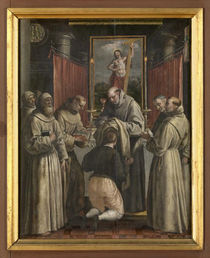The Catholic Defender: Saint Rose of Lima
- Donald Hartley

- Aug 23
- 4 min read
Updated: Aug 24
Deepertruth with special permission and aid with Franiciscan Media, a great team for the Lord

She is the patron saint of embroiderers, gardeners, florists, people who are harassed for their piety, and those suffering family problems. She is the patroness of the Americas, the indigenous people of the Americas, and of Peru, India, and the Philippines.
The Catholic Church says that many miracles followed her death: there were stories that she had cured a leper, and that, at the time of her death, the city of Lima smelled like roses; roses also started falling from the sky. Many places in the New World are named Santa Rosa after her.
The first canonized saint of the New World has one characteristic of all saints—the suffering of opposition—and another characteristic which is more for admiration than for imitation—excessive practice of mortification.
She was born to parents of Spanish descent in Lima, Peru, at a time when South America was in its first century of evangelization. She seems to have taken Catherine of Siena as a model, in spite of the objections and ridicule of parents and friends.
The saints have so great a love of God that what seems bizarre to us, and is indeed sometimes imprudent, is simply a logical carrying out of a conviction that anything that might endanger a loving relationship with God must be rooted out. So, because her beauty was so often admired, Rose used to rub her face with pepper to produce disfiguring blotches. Later, she wore a thick circlet of silver on her head, studded on the inside, like a crown of thorns.
When her parents fell into financial trouble, she worked in the garden all day and sewed at night. Ten years of struggle against her parents began when they tried to make Rose marry. They refused to let her enter a convent, and out of obedience she continued her life of penance and solitude at home as a member of the Third Order of Saint Dominic. So deep was her desire to live the life of Christ that she spent most of her time at home in solitude.
During the last few years of her life, Rose set up a room in the house where she cared for homeless children, the elderly, and the sick. This was a beginning of social services in Peru. Though secluded in life and activity, she was brought to the attention of Inquisition interrogators, who could only say that she was influenced by grace.
What might have been a merely eccentric life was transfigured from the inside.
If we remember some unusual penances, we should also remember the greatest thing about Rose: a love of God so ardent that it withstood ridicule from without, violent temptation, and lengthy periods of sickness. When she died at 31, the city turned out for her funeral. Prominent men took turns carrying her coffin.
It is easy to dismiss excessive penances of the saints as the expression of a certain culture or temperament. But a woman wearing a crown of thorns may at least prod our consciences. We enjoy the most comfort-oriented life in human history. We eat too much, drink too much, use a million gadgets, fill our eyes and ears with everything imaginable. Commerce thrives on creating useless needs on which to spend our money. It seems that when we have become most like slaves, there is the greatest talk of “freedom.” Are we willing to discipline ourselves in such an atmosphere?
St.Rose continued her self-martyrdom without pause, often with periods of ecstasy, until she died on August 24, 1617 at the age of thirty-one. She even prophesied the exact date of her death. With all the towns' people attending, the Archbishop himself, gave the eulogy at her Funeral Mass in the Cathedral.
Iconography. Here, the figure of Rose of Lima sprouts from a flower and holds her identifying symbol, a crown of roses, in her hand. These evoke the crown of thorns worn by Jesus at the Crucifixion. She also displays a tiny image of the Cathedral of Lima, the city where she spent most of her life.
Rose was outspoken against the corruption of Spanish wealth-seekers in the New World, and her sacrifices made a deep impression on the people of Lima. Many miracles followed her death in 1617.
She was beatified by Clement IX, in 1667, and canonized in 1671 by Clement X, the first American to be so honored. She was of the order of the Dominican tertiary. She was a Mystic, a Visionary and a Receiver of invisible stigmata.
for Giving Praise
Help me to remember what is really important: that I am Your child You are my Father You love me for who I am and how I live not what I look like or what I own. Let me praise You Who sees into my heart, Who is always with me and Who eases my suffering.





















Comments